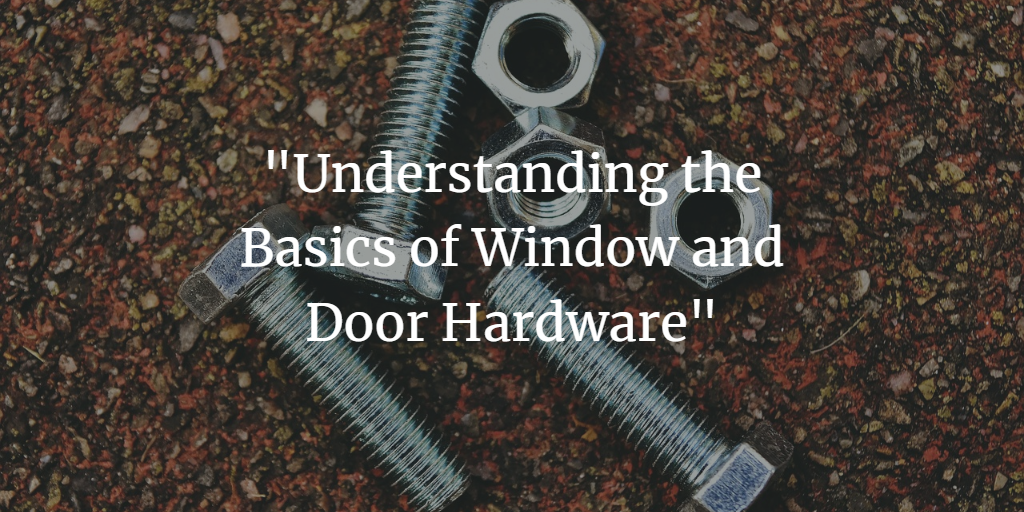Understanding the Basics of Window and Door Hardware

Starting and growing a business in the window and door hardware industry can be a rewarding and lucrative endeavor. In this article we will begin by going over the basics in the window and door hardware industry, and ultimately share with you all you need to know on how to sell more window and door hardware as a business. Let’s begin:
There are several different types of windows that can be used in a variety of settings, including residential, commercial, institutional, industrial, and business. Here is a breakdown of the most common types of windows and their typical parts:
Single Hung, Double Hung, and Casement Windows:
- Glazing Channel or Glazing Bead: This is the strip of material that holds the glass in place in the window frame.
- Screws: These are used to secure various parts of the window to the frame.
- Take Out Clip: This is a small clip that is used to hold the window sash in place when it is being removed or replaced.
- Jambliner: This is a strip of material that is used to seal the gap between the window sash and the frame.
- Top Sash Guide: This is a guide that helps the top sash of the window move up and down smoothly.
- Sash Stop: A stop that prevents the window sash from being raised too high.
- Sash Lock: A lock that is used to secure the window sash in place.
- Balance Retainer: This is a device that holds the balance system in place.
- Balance Bracket: This is a bracket that is used to support the balance system.
- Balance Ends: These are the end pieces of the balance system that get attached to the window sash.
- Tube Balances: These are tubes that are filled with a counterbalance weight and are used to help the window sash move up and down smoothly.
- Channel Balances: These are channels that are filled with a counterbalance weight and are used to help the window sash move up and down smoothly.
- Locking Handle: This is a handle that is used to lock the window sash in place.
- Sash Lock Keeper: This is a device that holds the sash lock in place.
Now when it comes to doors, there are many different types you may come across and each type of door serves a specific purpose. These doors can be patio doors, closet doors, entry/interior/exit doors, storm doors, shower doors, cabinet doors and drawers, or toilet partitions. However, you will be most likely to come across patio doors, bi-fold, and by-pass doors. Let’s take a closer look at those.
Patio Doors:
Patio doors are a popular choice for homeowners looking to add a sense of openness and light to their home. These doors are typically made of glass and allow for easy access to outdoor spaces. Some common parts for patio doors include:
- Guide: This part helps to keep the door in place and ensures that it opens and closes smoothly.
- Lock Pin: The lock pin helps to secure the door in place, preventing it from being opened by anyone other than the owner.
- Lock Keeper: This part works in conjunction with the lock pin to keep the door secure.
- Bumper: The bumper helps to protect the door and surrounding wall from damage when the door is closed.
- Handle Sets: These sets include the handles and lock mechanisms for opening and closing the door.
- Charley Bar Safety Lock: This lock is designed to add an extra layer of security to the door by preventing it from being forced open.
- Replacement Track: The track helps to guide the door as it opens and closes. A replacement track may be needed if the original track becomes damaged or worn out.
- Roller Assembly: The roller assembly helps the door to move smoothly along the track.
- Channel Glazing Bead: This part helps to hold the glass in place and gives the door a finished look.
Bi-Fold and By-Pass Closet Doors:
Bi-fold and by-pass closet doors are a popular choice for homeowners looking to save space and add a modern touch to their home. These doors are designed to fold or slide out of the way when not in use. Some common parts for bi-fold and by-pass closet doors include:
- Pivot Pin Assembly: This assembly helps to hold the door in place and allows it to pivot when opened.
- Top Track Assembly: The top track assembly helps to guide the door as it opens and closes.
- Guide Cap: The guide cap helps to keep the door in place and ensures that it moves smoothly along the track.
- Rubber Bumper: The rubber bumper helps to protect the door and surrounding wall from damage when the door is closed.
- Knob Assembly and Screw: The knob assembly and screw allow for easy opening and closing of the door.
- Bottom Track Assembly: The bottom track assembly helps to guide the door as it opens and closes.
- Pivot Bearing and Screw: The pivot bearing and screw help to hold the door in place and allow it to pivot when opened.
- Door Pull: The door pull allows for easy opening and closing of the door.
- Door Hanger: The door hanger helps to keep the door in place and ensures that it moves smoothly along the track.
- Floor Guide: The floor guide helps to keep the door in place and ensures that it moves smoothly along the track.


.jpg)